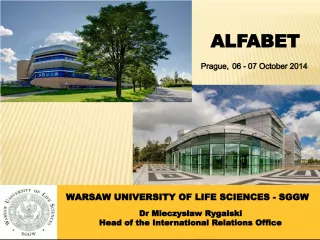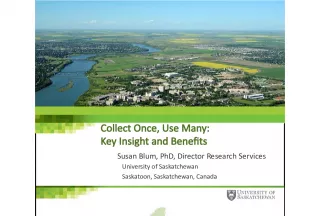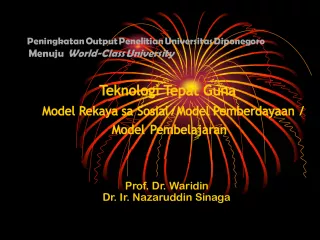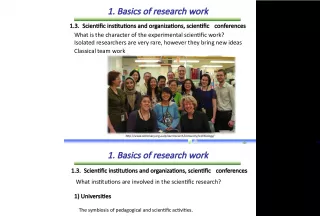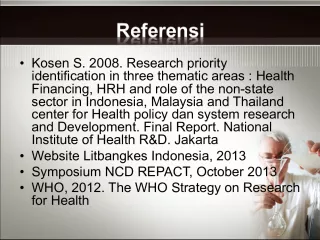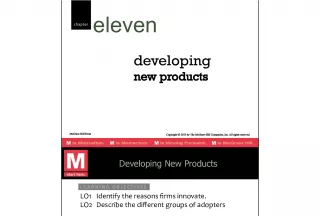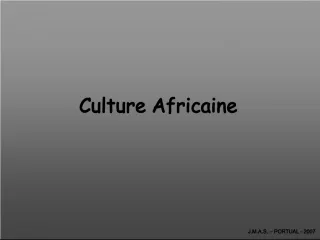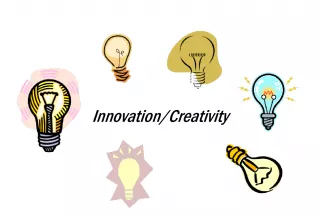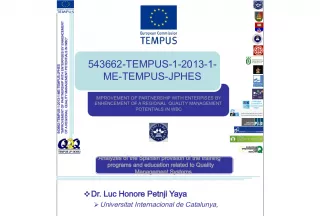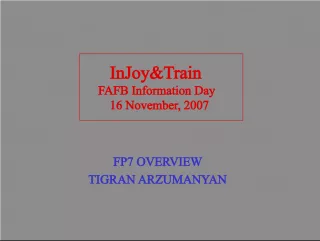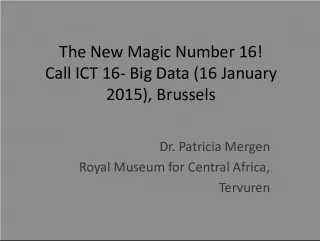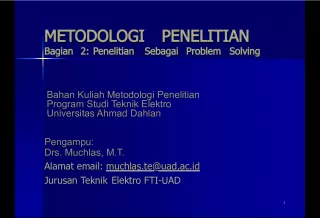Enhancing Research and Innovation in African Universities
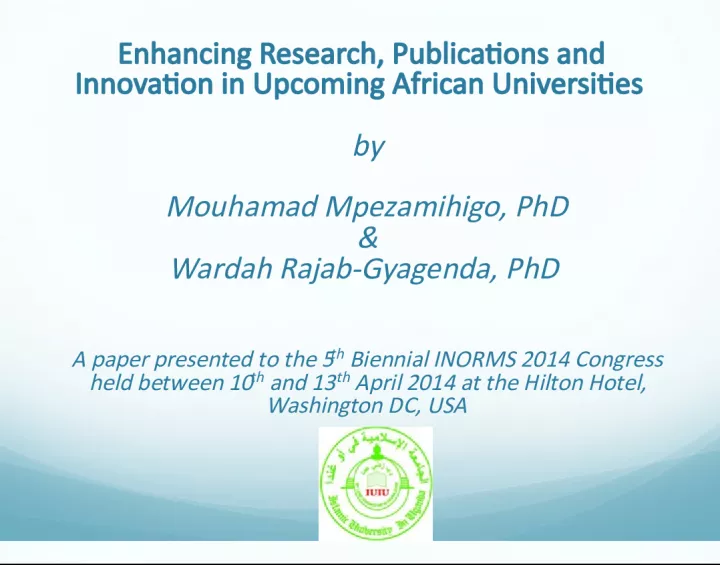

A paper presented at INORMS 2014 Congress, outlining challenges and conclusions based on a study of East African university statistics and summarized survey data.
- Uploaded on | 2 Views
-
 nellymader
nellymader
About Enhancing Research and Innovation in African Universities
PowerPoint presentation about 'Enhancing Research and Innovation in African Universities'. This presentation describes the topic on A paper presented at INORMS 2014 Congress, outlining challenges and conclusions based on a study of East African university statistics and summarized survey data.. The key topics included in this slideshow are . Download this presentation absolutely free.
Presentation Transcript
1. Enhancing Research, Publications and Innovation in Upcoming African Universities by Mouhamad Mpezamihigo, PhD & Wardah Rajab-Gyagenda, PhD A paper presented to the 5 th Biennial INORMS 2014 Congress held between 10 th and 13 th April 2014 at the Hilton Hotel, Washington DC, USA
2. 2 www.iuiu.ac.ug
3. PRESENTATION OUTLINE BACKGROUND EAST AFRICAN UNIVERSITY STATISTICS THE STUDY SUMMARIZED SURVEY DATA MAJOR CHALLENGES MAJOR CONCLUSIONS 3
4. BACKGROUND 4
5. BACKGROUND Over 10 years, student enrollment in Ugandan higher education expanded by 10% and university licensing by 30%. More public and private tertiary institutions have been started. In 1988 IUIU pioneered private higher education in Uganda. In the past 25 years it focused largely on teaching, learning and staff development. By 2013, 34 new universities were established in Uganda and several in Kenya, Tanzania, Rwanda and Burundi (the East African Federation/Community). Each country in the East African Federation has a national regulatory Agency that accredits both academic programmes and institutions. Many of the upcoming universities have recently established research offices/departments, and are engaged in limited research activities. 5
6. 6 LOCATION OF EA IN THE CONTINENT
7. MAP OF EAST AFRICA Source: maps-africa.blogspot.com, 8/4/2014 7
8. Higher education is seen as an instrument that develops individuals, society and national economies. Emerging policy changes that allow regulation of Universities and Tertiary Institutions include: a. Act 2001 as amended- for Uganda; b. Universities Act, No. 42 of 2012 as the successor to the Commission for Higher Education which was established under Universities Act Cap 210B of 1985 for Kenya; c. Universities Act (Chapter 346 of the Laws of Tanzania) for Tanzania; Public institutions can not absorb all the qualified students in the region nor can government afford to finance them ( M. Mpezamihigo, 2012 ). 8 EMERGENCE OF HE IN EA COUNTRIES
9. EAST AFRICAN UNIVERSITY STATS 9
10. CATEGORY % INCREASE RANK Business colleges 31.6 1 Management and Social Development 13.2 2 Theological Institutes 13.2 2 Affiliated Colleges 10.5 4 Universities 7.9 5 Health Colleges 7.9 5 Art and Design 7.9 5 Non-University Degree Award 5.3 8 Technical Colleges 2.6 9 Hotel/Tourism Institutes 2.6 9 Study Centres 2.6 9 TABLE 1 10 RANKING OF UGANDA HE EXPANSION BY CATEGORY (2006-2010)- Analysis
11. TABLE 2 11 RANKING OF UGANDA HE EXPANSION BY CATEGORY (2006-2010)- Cont. CATEGORY % INCREASE RANK Petroleum Institute 2.6 9 Research Centre 2.6 9 Media Institutes 0.0 14 Law development Centre 0.0 14 Aviation Colleges 0.0 14 Meteorology 0.0 14 Cooperative Colleges -2.6 18 Agricultural Colleges -2.6 18 Teachers Colleges -5.3 20
12. TABLE 3 12 STUDENT ENROLLMENT IN UGANDAN HE CATEGOR Y 2006 2010 NET INCREASE % INCREASE (5 YEARS) ANNUAL %INCREASE University 92,605 ( 67.5% ) 130,242 ( 70.8 ) 37,637 40.6 8.1 Others 44,585 ( 32.5 ) 53,743 ( 29.2 ) 9,158 20.5 4.1 Total 137,190 183,985 46,795 34.1 6.8 Universities in Uganda are currently offering more than 2000 Academic Programmes - (danger of duplications) Source: NCHE - 2006 and 2010 State of Higher Education in Uganda publications. Adopted from M. Mpezamihigo (2012).
13. KENYA UNIVERSITIES STATISTICS BY JUNE 2013 22 Public universities 9 Public University Constituent Colleges 17 Chartered Private Universities 5 Private University Constituent Colleges 12 Private Universities with Letter of Interim Authority 2 Registered Private Universities Source: www.cue.or.ke (April, 2014) 13
14. TANZANIA UNIVERSITIES STATISTICS BY APRIL 2014 11 Public universities 4 Public University Constituent Colleges 17 Private Universities 15 Private University Constituent Colleges 3 Centers for Public Universities 11Centers for Private Universities Source: www.tcu.go.tz (April, 2014) 14
15. THE STUDY 15
16. THE RESEARCH SCOPE This paper explores steps taken by East African universities to establish the following: a. Research offices/departments, b. Research publication and innovation agenda, as well as c. Efforts to mobilize research funding. The paper also highlights challenges these universities face in: a. Enhancing research, publication and innovation strategies, b. Building viable infrastructure, c. The highly competitive and global world of research grants, d. Funding faculty and student research, as well as e. Supporting faculty professional development 33 universities were surveyed, largely Ugandan based 16
17. THE SURVEY Questionnaires were designed and pre-tested. Preliminary data were collected from 33 universities. Data were processed and analyzed to provide the basis of this paper presentation. There was limited time to cover the entire East African region. There is plan to collect additional data. The study is ongoing 17
18. SUMMARISED SURVEY DATA 18
19. 19 TABLE 4 UNIVERSITY NAME COUNTRY PUBLIC (PU) / PRIVATE (PR) Bugema University Ug Pr Busitema University Ug Pr Busoga University Ug Pr Ecole Normale Superiore (ENS) Br Pr International Health Sciences University Ug Pr Islamic University in Uganda Ug Pr Kampala International University Ug Pr Kampala University Ug Pr Kumi University Ug Pr Kyambogo University Ug Pu Livingstone International University Ug Pr Masinde Muliro University of Science and Technology Ke Pu Mbarara University of Science and Technology Ug Pu Morogoro University Tz Pr Mountains of the Moon University Ug Pr Mutesa I Royal University Ug Pr Ndejje University Ug Pr Nkumba University Ug Pr St. Lawrence University Ug Pr The International University of East Africa Ug Pr Uganda Christian University Ug Pr Uganda Martyrs University Ug Pr United States International University Ke Pr University of Burundi Br Pu University of Nairobi Ke Pu Victoria University Ug Pr K ey: Ug-Uganda; Ke- Kenya; Tz-Tanzania; Br-Burundi 33 81.8% Ugandan 18.8% Other East African Countries 75.8% Private 24.2% Public 84.9% Established after 1990 (inclusive) 15.1% Established before 1990
20. Gender Frequency Percent Male 18 54.5 Female 14 42.4 Missing 1 3.0 Total 33 100 Qualification Frequency Percent Bachelors 3 9.1 Masters 20 60.6 PhD 10 30.3 Total 33 100.0 TABLE 5 TABLE 6 20 SOME DESCRIPTIVE STATISTICS
21. FIGURE 1 21
22. RESEARCH OFFICE, UNIT, DEPARTMENT OR DIRECTORATE 55% have a research Directorate 30% have a research unit 24% have a research department The study could not establish other details of unit, department or directorate FIGURE 2 22
23. RESEARCH AGENDA, POLICY AND PUBLICATIONS PER YEAR Research Agenda Frequency Percent Yes 28 84.8 No 5 15.2 Total 33 100.0 Research Policy Frequency Percent Yes 24 72.7 No 8 24.2 Missing 1 3.0 Total 33 100.0 Required Articles to be published per year per academic or research staff Frequency Percent 1-2 articles 15 45.45 3-4 articles 3 9.0 More than 4 articles 3 9.0 Missing 12 36.36 Total 33 100.0 Articles published per year Frequency Percent 1-3 publications 16 48.48 4-6 publications 3 9.0 10 publications and above 4 12.12 Missing 10 30.30 Total 33 100 TABLE 7 TABLE 8 TABLE 9 TABLE 10 23
24. RESEARCH BUDGET ALLOCATIONS Budget Vote Frequency Percent Yes 28 84.8 No 4 12.1 Missing 1 3.0 Total 33 100.0 TABLE 11 FIGURE 3 24
25. SOURCES OF RESEARCH FUNDS FIGURE 4 25
26. MAIN RESEARCH COLLABORATORS FIGURE 5 26
27. UNIVERSITY RESEARCH WEB-BASED PORTALS Only 30% of the universities surveyed had their research related information uploaded on the university official website. Even those that uploaded the information, most of it was scanty. Lack of information on the website did not mean that no research, publications and innovations are taking place but that very few if any outside the university settings are aware of what is going on. Recent (March 2014) universities exhibitions of universities and other tertiary institutions held in Kampala Uganda and organized by the National Council for Higher Education indicated that a lot is going on in the different universities but is not publicized. 27
28. MAJOR CHALLENGES 28
29. HE THE EAST AFRICAN REGION AND ITS CHALLENGES Governance: Failure to separate ownership from University management. Staff Capacity: Many lack senior staff to champion research and mentor young and upcoming scholars. More teaching: Lecturers carrying a lot of load and therefore do less of research and community out reach programmes. 29
30. Partnerships: Lack of industry-university partnerships Less Research: Generating less of new knowledge and providing solutions and striving to remain relevant. Facilities: Lack of modern facilities such as research labs, libraries, student centres, sports grounds etc Infrastructure: Poor ICT Infrastructure and intermittent bandwidth and therefore low use of ICTs in teaching, research and community out-reach 30 HE CHALLENGES Cont.
31. UNIVERSITY FINANCING- CRITICAL FACTOR Majority (90% or above) depend on tuition collections for their recurrent budgets and less is allocated for research activities No university can charge unit cost for courses it offers, not even for the non-laboratory based or field intensive academic programmes. Frugal financial management is one of the greatest requirements for successful provision of private university education. 31
32. FUNDING SOURCE DIVERSIFICATION University own corporations, Tuition fees ( should not exceed 40% ) External research grants ( great potential exists ) Commercial and consultancy activities Establishing endowments Donations from Alumni and other philanthropists ( remains untapped in African universities ) Government subventions and tax waivers ( difficult to achieve ) 32
33. MAJOR CONCLUSIONS 33
34. CONCLUSIONS Teaching Focused: Most of the Upcoming Ugandan Universities are mainly teaching and doing less of research due to several factors such as lack of adequate resources, teaching overloads, and issues affecting the general administration of universities. Locally Funded: Majority of universities obtain research funds mainly from internally generated resources, which are competed for by other activities like recurrent budgets and capital development. New Institutions: Many of the universities surveyed are still young and lack senior staff to mentor the young scholars into rigorous research, publications and innovation. 34
35. CONCLUSIONS Cont. Low Publications: Although majority indicated having established research offices, the publications output is still at its lowest. Internal Collaborations: Most of the collaborations are done internally within the university, thereby missing out on opportunities external to the home institutions. Web-Postings: Most of the universities do not post research information on their websites, which limits the visibility of the institution to the outside world. 35
36. RESEARCH PENDING IN THIS STUDY Additional data on Publications and innovations Rolling out to universities outside Uganda in order to complete the original objective of the paper. Comparing the same in other African regions (West Africa, North Africa and Southern Africa) 36
37. ACKNOWLEDGEMENT INORMS 2014 organizing Team and SRA International for accepting our abstract and presentation. Research team: Dr. Wardah Rajab-Gyagenda Sharif Waliggo Yusuf Kaweesi Dr. Musa Matovu Mrs. Amaal Kinene of Kampala University who facilitated the distribution of questionnaires to different Universities in Uganda. Islamic University in Uganda who financed my trip to INORMS 2014. 37
38. 38 www.iuiu.ac.ug THANK YOU CELEBRATING 26 YEARS of existence ( 1988-2014 )
